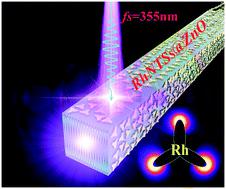当前位置:
X-MOL 学术
›
CrystEngComm
›
论文详情
Our official English website, www.x-mol.net, welcomes your feedback! (Note: you will need to create a separate account there.)
Employing rhodium tripod stars for ultraviolet plasmon enhanced Fabry–Perot mode lasing
CrystEngComm ( IF 3.1 ) Pub Date : 2020-07-06 , DOI: 10.1039/d0ce00890g Changzong Miao 1, 2, 3, 4, 5 , Haiying Xu 1, 2, 3, 4, 6 , Mingming Jiang 1, 2, 3, 4, 5 , Jiaolong Ji 1, 2, 3, 4 , Caixia Kan 1, 2, 3, 4, 5
CrystEngComm ( IF 3.1 ) Pub Date : 2020-07-06 , DOI: 10.1039/d0ce00890g Changzong Miao 1, 2, 3, 4, 5 , Haiying Xu 1, 2, 3, 4, 6 , Mingming Jiang 1, 2, 3, 4, 5 , Jiaolong Ji 1, 2, 3, 4 , Caixia Kan 1, 2, 3, 4, 5
Affiliation

|
Plasmon-enhanced semiconductor optoelectronic devices, particularly lasers, have attracted intense interest due to their significantly improved optical quality and the presence of microresonators. In this work, Rh tripod stars (RhNTSs) with tunable plasmonic properties in the ultraviolet band were synthesized and spin-coated on the surface of a single ZnO microwire, different from the traditional sputtering method. The near-band-edge emission of the ZnO microwire was significantly enhanced due to the presence of the RhNTSs on the surface. Additionally, the bilateral smooth surface of the single ZnO microwire with rectangular-shaped cross section enabled the achievement of lateral-resonator Fabry–Perot (FP) microlasers. Thus, a special FP mode is adopted to investigate the modulation effect of RhNTS plasmons with ultraviolet response on the lasing properties of the single ZnO microwire. Upon resonant ultraviolet excitation, the deposited RhNTSs on the surface of the ZnO microwire can be utilized to improve the FP lasing performance, specifically to decrease the threshold and enhance the lasing output. The enhanced performance of the ZnO microwire originates from the localized-field enhancement induced by the RhNTSs, which can compensate for the optical loss and promote more radiative photons into the FP microresonators. These results indicate that the RhNTSs with unique ultraviolet plasmonic features can be extensively employed to enhance the optoelectronic performances of wide bandgap semiconductor materials and devices, suggesting their potential applications in ultraviolet light-emitting diodes and lasers, photodetectors and so on.
中文翻译:

利用铑三脚架星进行紫外线等离子体激元增强的Fabry-Perot模式激光
等离子体增强的半导体光电器件,尤其是激光器,由于其光学质量的显着提高和微谐振器的存在而引起了人们的极大兴趣。在这项工作中,与传统的溅射方法不同,合成了在紫外波段具有可调等离子体特性的Rh三脚架星(RhNTSs),并将其旋涂在一条ZnO微丝的表面上。由于表面上存在RhNTS,大大提高了ZnO微线的近带边缘发射。此外,具有矩形横截面的单根ZnO微丝的双侧光滑表面使得能够实现横向谐振法布里-珀罗(FP)微激光。从而,采用特殊的FP模式研究具有紫外响应的RhNTS等离激元对单根ZnO微丝激光发射特性的调制作用。在共振紫外线激发下,可以利用在ZnO微丝表面沉积的RhNTS来改善FP激射性能,特别是降低阈值并提高激射输出。ZnO微线的增强性能源自RhNTS引起的局部场增强,可以补偿光学损耗并促进更多的辐射光子进入FP微谐振器。这些结果表明,具有独特的紫外线等离子体特征的RhNTS可以广泛用于增强宽带隙半导体材料和器件的光电性能,
更新日期:2020-09-01
中文翻译:

利用铑三脚架星进行紫外线等离子体激元增强的Fabry-Perot模式激光
等离子体增强的半导体光电器件,尤其是激光器,由于其光学质量的显着提高和微谐振器的存在而引起了人们的极大兴趣。在这项工作中,与传统的溅射方法不同,合成了在紫外波段具有可调等离子体特性的Rh三脚架星(RhNTSs),并将其旋涂在一条ZnO微丝的表面上。由于表面上存在RhNTS,大大提高了ZnO微线的近带边缘发射。此外,具有矩形横截面的单根ZnO微丝的双侧光滑表面使得能够实现横向谐振法布里-珀罗(FP)微激光。从而,采用特殊的FP模式研究具有紫外响应的RhNTS等离激元对单根ZnO微丝激光发射特性的调制作用。在共振紫外线激发下,可以利用在ZnO微丝表面沉积的RhNTS来改善FP激射性能,特别是降低阈值并提高激射输出。ZnO微线的增强性能源自RhNTS引起的局部场增强,可以补偿光学损耗并促进更多的辐射光子进入FP微谐振器。这些结果表明,具有独特的紫外线等离子体特征的RhNTS可以广泛用于增强宽带隙半导体材料和器件的光电性能,



























 京公网安备 11010802027423号
京公网安备 11010802027423号